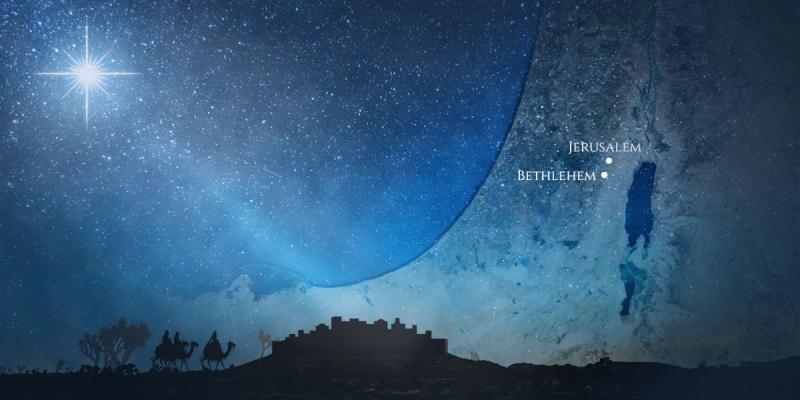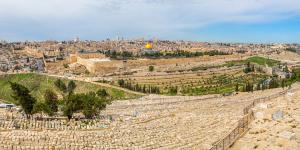You are here
Book of Mormon Central is in the process of migrating to our new Scripture Central website.
We ask for your patience during this transition. Over the coming weeks, all pages of bookofmormoncentral.org will be redirected to their corresponding page on scripturecentral.org, resulting in minimal disruption.
In a prophecy about the coming of the Savior, the Nephite High Priest Alma said, “And behold, he shall be born of Mary, at Jerusalem which is the land of our forefathers” (Alma 7:10).1 Following a remark published in 1831 by Alexander Campbell, some readers have noted with no little amusement that the Book of Mormon seems to say that Jesus was born in the city of Jerusalem, not the village of Bethlehem.2 But in Alma’s statement to the people of Gideon, he spoke not of a specific town, but prophesied that Jesus would be born at or in the “land” from which Lehi’s family came.
The small town of Bethlehem is only about 8 miles from the center of Jerusalem, which was the political and religious capital of Lehi’s homeland. Bethlehem was known as the home of King David, but otherwise it was seen as an insignificant place in Lehi’s day. In fact, recent archaeological evidence suggests that within or close to Lehi’s lifetime, Bethlehem was a “satellite settlement” to Jerusalem.3 A fiscal bulla (clay seal impression) found in Jerusalem and inscribed with the name Bethlehem was discovered and dated to the 7th century BC,4 indicating that Bethlehem was “linked to the nearby city of Jerusalem” at this time.5
Bethlehem would have been all the more insignificant to Alma’s audience in the Nephite land of Zarahemla. The Nephites cared little about the Davidic monarchy, and by Alma’s day they had been far away from the land of Israel for over 500 years. Thus, Alma would naturally have referred generally to the land where Jesus would be born and not to an obscure outlying suburb.
Moreover, referring to Jerusalem and its environs as a “land” was a proper geographical usage. For instance, it can be found in the El Amarna tablets in Egypt, which date to the fourteenth century B.C. These tablets were unknown in 1829 and were discovered in Upper Egypt in 1887, well after the Book of Mormon was translated and published. The ancient writer of these texts knew Akkadian and the affairs of the lands around Jerusalem. He referred to “the land of Jerusalem” in language similar to Alma’s. The ancient tablet reads:
“And now as for Jerusalem—Behold this land belongs to the king”
“But now even a town of the land of Jerusalem, Bit-Lahmi by name, a town belonging to the king, has gone over to the side of the people of Keilah.”6
According to Professor William F. Albright, who translated this text, Bit-Lahmi “is an almost certain reference to the town of Bethlehem, which thus appear for the first time in history.”7 Some scholars have questioned this identification, but it remains widely accepted by biblical scholars today.8 Not only does the Amarna text consider Jerusalem to be a “land,” but this text also speaks of Bethlehem (the town where Jesus would later be born) as belonging to the “land of Jerusalem.” Thus, the specific phrasing of Alma’s prophecy stands in excellent ancient company.
- 1. Emphasis added.
- 2. Alexander Campbell, “Delusions,” Millennial Harbinger (February 7, 1831): 93.
- 3. Nadav Naʾaman, “Josiah and the Kingdom of Judah,” in Good Kings and Bad Kings: The Kingdom of Judah in the Seventh Century BCE, ed. Lester L. Grabbe (New York, NY: T&T Clark, 2005), 198–199 explains that Jerusalem at the time of Josiah would have ruled a district (or “land”) encompassing “satellite settlements directly connected to Jerusalem proper.”
- 4. Ronny Reich, “A Fiscal Bulla from the City of David,” Israel Exploration Journal 62, no. 2 (2012): 200–205.
- 5. “Ancient Bethlehem Seal Unearthed in Jerusalem,” Phys.org, May 23, 2012, online at https://phys.org/news/2012- 05-ancient-bethlehem-unearthed-jerusalem.html (accessed December 6, 2017).
- 6. W. F. Albright, trans., “The Amarna Letters,” in The Ancient Near East: An Anthology of Texts and Pictures, ed. James B. Pritchard (Princeton, NJ: Princeton University Press, 2011), 437–440.
- 7. Albright, “The Amarna Letters,” 440 n. 15.
- 8. See Edward F. Campbell Jr., Ruth: A New Translation with Introduction, Notes, and Commentary, Anchor Bible 7 (New York, NY: Double Day, 1975), 54; R. Dennis Cole, “Bethlehem,” in Eerdmans Dictionary of the Bible, ed. David Noel Freedman (Grand Rapids, MI: Wm. B. Eerdmans, 2000), 172–173; Markus Bockmuehl, This Jesus: Martyr, Lord, Messiah (New York, NY: T&T Clark, 2004), 25; Eugen J. Pentiuc, Jesus the Messiah in the Hebrew Bible (New York/Mahwah, NJ: Paulist Press, 2006), 137 n. 67; Jerome MurphyO’Connor, Keys to Jerusalem: Collected Essays (New York, NY: Oxford University Press, 2012), 5.
Further Reading
Neal Rappleye, “Letters of ʿAbdu-Ḫeba (EA 285–290),” Nephite History in Context 2 (December 2017): 6–13.
Neal Rappleye, “Bethlehem Bulla,” Nephite History in Context 2 (December 2017): 14–17.
Hugh Nibley, Lehi in the Desert (Salt Lake City, UT: FARMS and Deseret Book, 1988), 6–7.
John W. Welch, ed., Reexploring the Book of Mormon (Salt Lake City: FARMS and Deseret Book, 1992), 170–172.
John W. Welch and Melvin J. Thorne, eds., Pressing Forward with the Book of Mormon (Provo: FARMS, 1999), 139–141.




